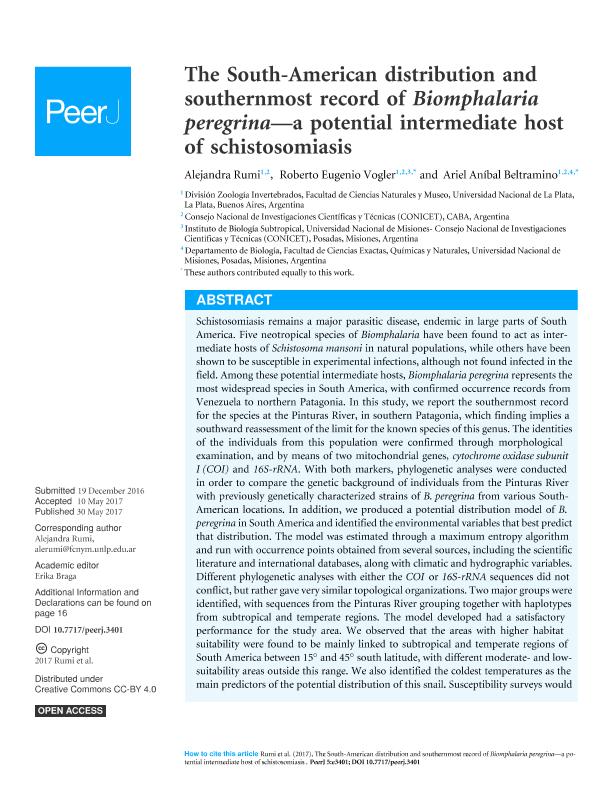Mostrar el registro sencillo del ítem
dc.contributor.author
Rumi Macchi Z., Alejandra

dc.contributor.author
Vogler, Roberto Eugenio

dc.contributor.author
Beltramino, Ariel Anibal

dc.date.available
2018-05-29T16:21:00Z
dc.date.issued
2017-05
dc.identifier.citation
Rumi Macchi Z., Alejandra; Vogler, Roberto Eugenio; Beltramino, Ariel Anibal; The South-American distribution, southernmost record, and genetic variability of Biomphalaria peregrina - a potential intermediate host of schistosomiasis; PeerJ Inc; PeerJ; 5; 3401; 5-2017; 1-26
dc.identifier.issn
2167-8359
dc.identifier.uri
http://hdl.handle.net/11336/46431
dc.description.abstract
Schistosomiasis remains a major parasitic disease, endemic in large parts of South America. Five neotropical species of Biomphalaria have been found to act as intermediate hosts of Schistosoma mansoni in natural populations, while others have been shown to be susceptible in experimental infections, although not found in the field. Among these potential intermediate hosts, Biomphalaria peregrina represents the most widespread species in South America, with confirmed occurrence records from Venezuela to northern Patagonia. In this study, we report the southernmost record for the species at the Pinturas River, in southern Patagonia, which finding implies a southward displacement of the limit for the known species of this genus. The identities of the individuals from this population were confirmed through morphological examination, and by means of two mitochondrial genes, cytochrome oxidase subunit I (COI) and 16S-rRNA. With both markers, phylogenetic analyses were conducted to assess the pattern of genetic variation of B. peregrina, and to explore evolutionary relationships of these southernmost individuals from the Pinturas River through available DNA sequences for the species from various locations. In addition, we produced a potential distribution model of B. peregrina in South America and identified the environmental variables that best predict that distribution. The model was estimated through a maximum entropy algorithm and run with occurrence points obtained from several sources, including the scientific literature and international databases, along with climatic and hydrographic variables. Different phylogenetic analyses with either the COI or 16S-rRNA sequences did not conflict, but rather gave very similar topological organizations. Two major groups were identified, with sequences from the Pinturas River grouping together with haplotypes from subtropical and temperate regions. The model developed had a satisfactory performance for the study area. We observed that the areas with higher habitat suitability were found to be mainly linked to subtropical and temperate regions of South America between 15° and 45° south latitude, with different moderate- and low-suitability areas outside this range. We also identified the coldest temperatures as the main predictors of the potential distribution of this snail, which thermal driver could act as a climatic barrier for the spread of schistosomiasis into temperate regions. Nonetheless, susceptibility surveys would be required to evaluate if southern populations of B. peregrina still retain their potential as intermediate hosts of S. mansoni.
dc.format
application/pdf
dc.language.iso
eng
dc.publisher
PeerJ Inc
dc.rights
info:eu-repo/semantics/openAccess
dc.rights.uri
https://creativecommons.org/licenses/by/2.5/ar/
dc.subject
Gastropoda
dc.subject
Planorbidae
dc.subject
Potential Distribution
dc.subject
South America
dc.subject.classification
Otras Ciencias Biológicas

dc.subject.classification
Ciencias Biológicas

dc.subject.classification
CIENCIAS NATURALES Y EXACTAS

dc.title
The South-American distribution, southernmost record, and genetic variability of Biomphalaria peregrina - a potential intermediate host of schistosomiasis
dc.type
info:eu-repo/semantics/article
dc.type
info:ar-repo/semantics/artículo
dc.type
info:eu-repo/semantics/publishedVersion
dc.date.updated
2018-05-16T14:45:25Z
dc.identifier.eissn
2167-8359
dc.journal.volume
5
dc.journal.number
3401
dc.journal.pagination
1-26
dc.journal.pais
Estados Unidos

dc.journal.ciudad
Corte Madera
dc.description.fil
Fil: Rumi Macchi Z., Alejandra. Universidad Nacional de la Plata. Facultad de Ciencias Naturales y Museo. División Zoología Invertebrados; Argentina. Consejo Nacional de Investigaciones Científicas y Técnicas; Argentina
dc.description.fil
Fil: Vogler, Roberto Eugenio. Universidad Nacional de la Plata. Facultad de Ciencias Naturales y Museo. División Zoología Invertebrados; Argentina. Consejo Nacional de Investigaciones Científicas y Técnicas. Centro Científico Tecnológico Conicet - Nordeste. Instituto de Biología Subtropical. Instituto de Biología Subtropical - Nodo Posadas | Universidad Nacional de Misiones. Instituto de Biología Subtropical. Instituto de Biología Subtropical - Nodo Posadas; Argentina
dc.description.fil
Fil: Beltramino, Ariel Anibal. Universidad Nacional de la Plata. Facultad de Ciencias Naturales y Museo. División Zoología Invertebrados; Argentina. Consejo Nacional de Investigaciones Científicas y Técnicas. Centro Científico Tecnológico Conicet - Nordeste. Instituto de Biología Subtropical. Universidad Nacional de Misiones. Instituto de Biología Subtropical; Argentina
dc.journal.title
PeerJ
dc.relation.alternativeid
info:eu-repo/semantics/altIdentifier/url/https://peerj.com/articles/3401/
dc.relation.alternativeid
info:eu-repo/semantics/altIdentifier/doi/http://dx.doi.org/10.7717/peerj.3401
Archivos asociados
